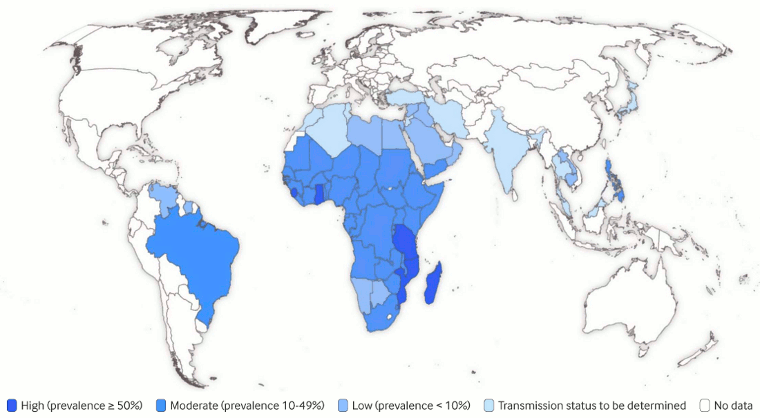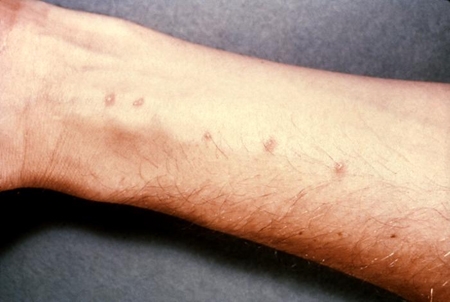History and exam
Key diagnostic factors
common
geographic exposure
Travel or residence history is the most important element in defining infection risk.[36] Absence of any history of exposure to endemic areas makes the diagnosis of schistosomiasis extremely unlikely.[36]
[Figure caption and citation for the preceding image starts]: Map of geographic distribution and prevalence of Schistosoma sppAdapted from Salas-Coronas J et al. Aten Primaria. 2022 Aug;54(8):102408; used with permission [Citation ends].
abdominal pain
Can be nonspecific or severe. Localization of tenderness can aid in directing further diagnostic workup.
hematuria
Apparent >50% of the time with egg-induced granuloma formation in urinary schistosomiasis.[56]
This symptom is also associated with bladder cancer.
uncommon
hematemesis
Indicates esophageal variceal development with portal hypertension.[54]
Other diagnostic factors
common
rash
Can occur with initial skin infection (in approximately one third of cases following exposure to contaminated water)[Figure caption and citation for the preceding image starts]: Mild cercarial dermatitis (swimmer's itch)CDC; used with permission [Citation ends]. and with immune complex reaction to initial egg deposition (Katayama syndrome).[19]
and with immune complex reaction to initial egg deposition (Katayama syndrome).[19]
fever
dysuria
Apparent in 33% to 60% of patients with egg-induced granuloma formation in urinary schistosomiasis.[56]
This symptom is also associated with bladder cancer.
hepatosplenomegaly
Can occur in 35% of patients with an acute infection or 55% of those with a chronic infection, and is associated either with egg-induced granulomatous inflammation or with portal hypertension.
uncommon
dyspnea
Progressive dyspnea due to lung fibrosis and subsequent pulmonary hypertension may occur in chronic schistosomiasis.
bloody diarrhea
pelvic pain
Approximately 11% of patients with biopsy-demonstrated schistosomiasis have pelvic pain.[61]
infertility or history of ectopic pregnancy
ascites
Associated with portal hypertension.[62]
genital ulcers
Focal lesions and epithelial erosion (especially cervical) can be found in 13% of women infected with Schistosoma haematobium.[42]
Risk factors
strong
skin exposure to contaminated freshwater
Schistosomiasis is transmitted by only certain species of freshwater snails, but specific areas where these snails thrive is not well documented, and egg-containing human sewage can get washed into the water, resulting in contamination.[20]
travel to endemic areas
Schistosoma infection can be transmitted within 30 seconds when tourists enter freshwater containing infectious parasite larvae (cercariae).[19][25][27][28] Schistosomiasis is found in Africa, the Middle East, the Far East, and in parts of South America and the Caribbean.[14] Schistosomiasis has been reported in Corsica, France, likely due to introduction of the parasite by immigrants, and in Almeria, Spain.[8][29]
[Figure caption and citation for the preceding image starts]: Map of geographic distribution and prevalence of Schistosoma sppAdapted from Salas-Coronas J et al. Aten Primaria. 2022 Aug;54(8):102408; used with permission [Citation ends].
age 4 to 15 years
occupational exposure
Adult fishermen, canal cleaners, car washers, and irrigation workers are at highest risk in some areas. Work roles specific to men and women may determine occupational water exposure and consequent risk for schistosomiasis.[15]
Use of this content is subject to our disclaimer